Dental Implants
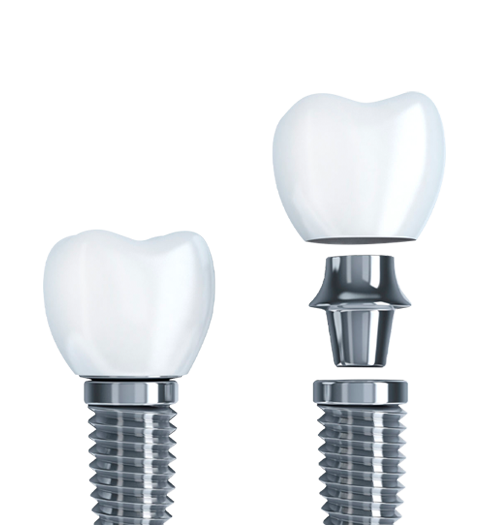

Overview
What is a Dental Implant?
A dental implant is a small screw usually made out of titanium, that replaces the root portion of a missing natural tooth. Due to the biocompatible properties of titanium, the dental implant fuses with the bone and becomes a secure anchor for the replacement tooth.
People in good health have the best chance for successful implants, but having health issues doesn’t automatically preclude patients from getting dental implants. Success rates of dental implants are lower in smokers, and chronic conditions such as diabetes can delay healing.
You need to care for your implants in the same way you do for real teeth – with diligent oral hygiene and regular dentist visits.
There are three parts involving an implant as illustrated below:
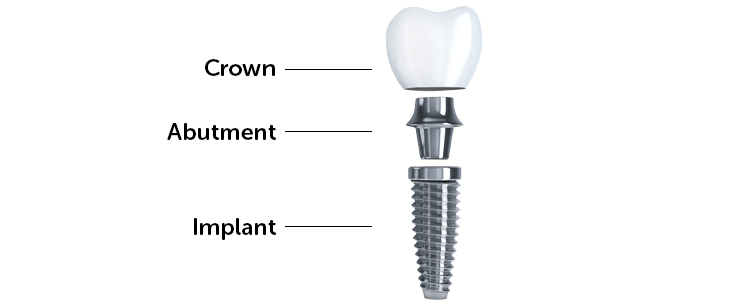
Implant Scenarios
Dental implants are an option for people who have:
- A single tooth missing
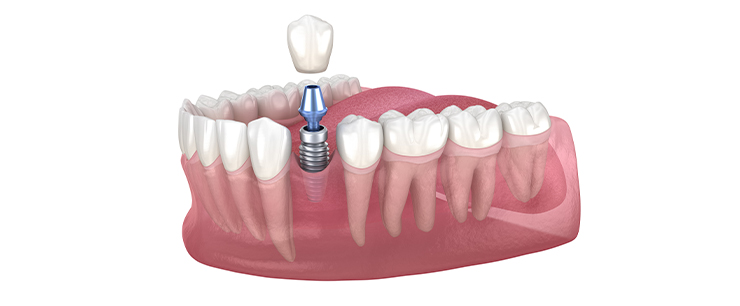
When you have a conventional dental bridge, the procedure involves crowning teeth at either side of the gap. Unlike a conventional bridge, dental implants do not affect the adjacent teeth.
- Several teeth missing
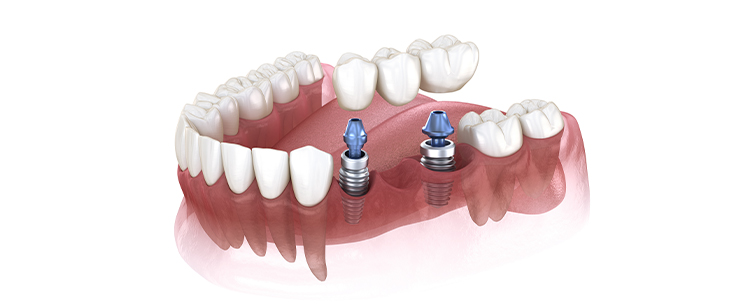
When you have multiple teeth missing, an implant bridge can be used to fill the gap. The implants are inserted just like a single implant, and then an implant bridge is placed over the implants. The bridge is placed from one implant to the other implant, and there is no need to crown any of the adjacent teeth.
- All teeth missing
Option 1 - Conventional implants with zirconium crowns

In this option a full set of implants are recommended. This would require a maximum of eight implants on the upper jaw and a minimum of six implants on the lower jaw. Two sets of zirconium crowns are then placed on the upper and lower jaws.
Option 2 – All-on system implants with a click system acrylic cast denture
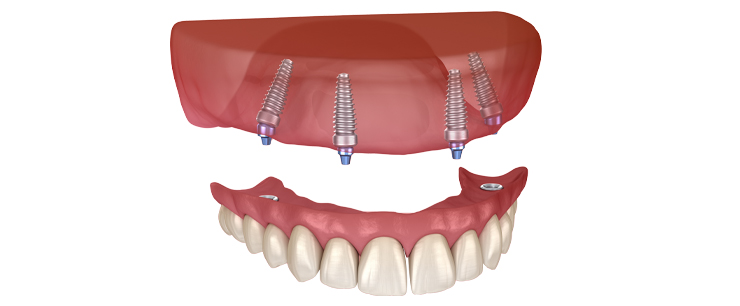
The second option is to have implants and a click denture system. Four implants are placed on the upper jaw and four implants are placed on the lower jaw. Then an acrylic cast denture is placed over the implants using a click system. The denture clicks on the implants, setting your dentures firmly in place. The denture can be removed without an effort, so the dentures are easy to maintain.
How Do I Know If I'm a Suitable Candidate for Dental Implants?
If you consider having implants, you must have healthy gums and adequate bone to support the implant. These are major factors affecting the success and outcome of the implant surgery. It is advisable to have an X-ray for the evaluation of your gums, teeth and bone prior to travelling abroad to have implants. This will help us in providing you with specific information on the details of the treatment including the duration and the cost of the treatment.
Implants may be contraindicated if a patient is taking intravenous or oral bisphosphonates as this may put a patient at a higher risk for osteonecrosis . Osteonecrosis is a bone disease which results from the loss of blood supply to the bone.
Related Procedures
Bone Augmentation
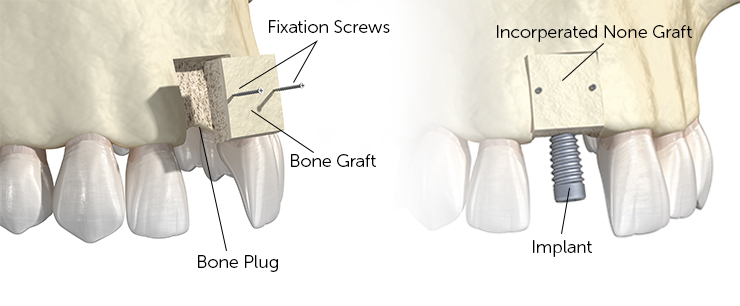
When a tooth is missing for a long period of time (even if you are using a removable denture), it leads to significant decrease in the strength and thickness of the jawbone, which is called jawbone resorption or bone loss. A dental implant is the only form of tooth replacement that prevents bone resorption. However, in order to successfully place the implant, there has to be sufficient jawbone.
If there is not enough bone, or if the tissue is too soft for the implant to be placed, bone augmentation is necessary. Bone augmentation is replacement of missing bone. Your dentist inserts artificial (synthetic) bone into the area where the implant will be placed. Healing time is usually six to eight weeks. After the healing period, implants can be placed.
Sinus Lifting
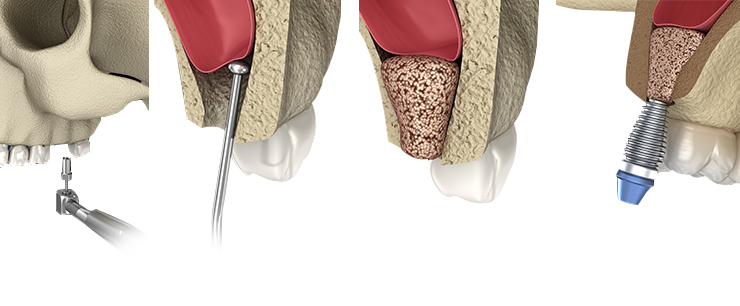
Sinus lifting is required when there is insufficient bone available to securely place the dental implant. When upper back teeth are missing for a long period of time in the upper jaw, bone in that area shrinks or resorbs. Your sinuses expand to occupy the empty space where the bone used to be. The sinuses must be lifted in order to create space for placing additional bone in that area. The bone is added between your jaw and maxillary sinuses to make space for the implant.
Benefits of Dental Implants
- Dental implants both feel and look like your natural teeth with no chewing or speaking difficulties or “clicking” noises that can occur with dentures. In addition, they’ll give you back your smile, enabling you to enjoy yourself socially without being self-conscious.
- You can brush and floss your dental implants just like regular teeth. Prosthesis over implants don’t have to be removed before sleeping at night either, which allows you to maintain your lifestyle at any hour.
- The way implants are installed ensures that there will not be any slippage, so you will not have to worry – as sometimes happens with dentures.
- The materials used in the implants (typically titanium) are durable and bio-compatible, so the chances of either damage or an allergic reaction are minimised.
- Unlike bridges, implants don’t rely on neighbouring teeth for support, which can help protect remaining teeth from damage. And, unlike dentures, bone loss is usually avoided since dental implants actually replace the tooth and its root.
- Dental implants are considered long-term replacements that can last a lifetime provided that they are maintained properly, while bridges and removable dentures may need replacing every 7 to 10 years.
Procedure
Before the Procedure
Before having the procedure, a full oral examination will be performed by your dentist and oral surgeon. OPG (panoramic x-ray) or CT scan of the patient will also be evaluated before the consultation. These are used to analyse the density of the bone where the implant(s) will be placed. Local anaesthesia is adequate for this procedure as the only pain you experience is the prick of the anaesthesia needle and some amount of pressure.
Please remember to eat and drink fluids (non-alcoholic) as normal before the procedure, do not miss breakfast and take all of your medications at normal times.
During the Procedure
Phase 1
Once your dentist is assured that your jawbone is healthy enough to receive an implant, the gum tissue is opened and a channel is created deep into the bone to place the implant with a special drill under local anaesthesia.
Depending on the density and anatomic structure of the bone your dentist will choose the type as well as the length of the implant. The implant is then placed in the channel and the gum is sutured or stitched back. In some cases, your dentist may not close the gum and place an abutment directly on to the implant.
If you already use a denture, you will continue to use it during the healing process, otherwise, a temporary prosthesis might be placed. Current dentures might be adjusted to fit better when needed.
The healing time is usually 3 to 6 months. During the healing period, the implant fuses to the bone and acts like a natural tooth root. Upon successful osseointegration, which is the structural connection that forms between your natural jawbone and the titanium implant, you move forward to the next phase.
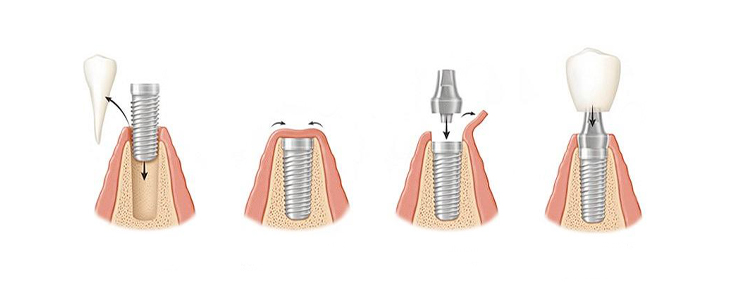
Phase 2
The gum is re-opened to expose the implant. Then an abutment is screwed and tightened to the dental implant using special dental equipment. After this is done, a temporary crown is placed onto the abutment as the abutment needs to be protected from biting forces to ensure successful healing. The temporary crown is used for a few days until the permanent crown is ready.
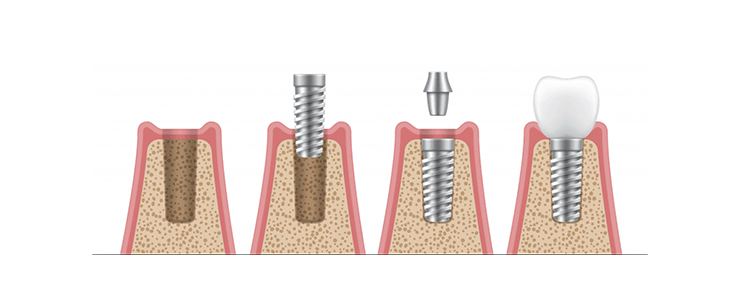
After the Procedure
After-care
- Avoid hot drinks or hot food for the first day.
- Do not eat until the local anaesthetic lose effect.
- Try not to rub or touch the area with your fingers or tongue.
- Try to wear your denture as little as possible if it covers the implant area. If the denture does not seem to fit properly after your surgery, then, you should have it adjusted. A badly-fitting denture can damage a healing implant.
- Stitches are normally dissolvable; they usually remain around 2-3 weeks.
- A patient should avoid excessive exercise up to 48 hours post-surgery.
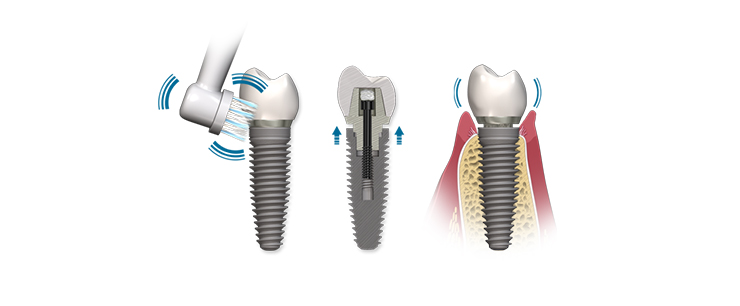
Complications
- Moderate pain is normal for a few days following surgery and it can be easily managed with pain killers. If pain starts getting worse rather than getting better after 3-4 days, you should schedule an appointment with your dentist.
- You need to use antibiotics that will be prescribed by your dentist to avoid the risk of infection. You need to complete the full course of antibiotics.
- Swelling is normal after dental implant surgery and it can be worse in the morning after lying flat throughout the night. Swelling usually subsides after 48 hours and can be reduced with ice packs. Place them on the cheek for 10 minutes at a time with 15-minute breaks.
- There may be some bruising on the skin, but it will clear up in a few days.
- Some bleeding following surgery is normal. If it persists, apply pressure with a dampened gauze for up to 30 minutes.
- It is very important to refrain from smoking for at least two months after the placement of the implants as smoking is a major factor for the risk of failure.
- After the crown or denture has been placed, some sensitivity might be experienced. Pain killers can be taken to address the issue. Pain should subside after 2-3 days.
Brands
Itinerary
In most cases, you need to visit Turkey twice to complete your treatment provided that you don’t suffer from bone loss.
1 st visit (surgery for the insertion of dental implants)
1 week, 1-3 appointments
Full integration between implant and jawbone (duration between the visits) usually takes 3 to 6 months, instant loading of the prosthesis over implants being possible in some cases.
2 nd visit (prosthesis over implants)
1 week, 3-5 appointments for zirconium bridges over conventional implants
10 days, 3-5 appointments for click system acrylic cast denture over all-on system implants
FAQ
What’s the difference between all-on system implants and conventional implants?
The implants serve the same function for both types of solutions, but the difference in the materials used to make the bridge over the implants significantly affects its final look, feel, and performance over time. A click system with a removable acrylic cast denture is used over allon system implants whereas fixed zirconium bridges are used over conventional implants.
Acrylic bridges with denture teeth Full arch zirconium bridges over over all-on system implants conventional implants
Much more stable and actually form
Puts stress on the supporting a supporting structure that implants resulting in bridge
Fit and function minimises any movement and stress
movement when chewing on the implants
Lifespan is much shorter. Eating
Much more durable. Withstands take a steady and gradual toll on
Durability significant pressure and resists
the acrylic resin, causing it to break chipping, fractures and wear.
down over time.
Solid. Achieve a bite and smile that is Porous (contains pores). Tend to
Appearance virtually indistinguishable from
look artificial, and stain easily. healthy, natural teeth. Doesn’t stain.
Requires more maintenance time
Maintenance i.e. removable dentures have to be Easy to clean taken out to wash
Doesn’t attract plaque and bacteria, Prone to attract plaque and
Hygiene so minimises the risk of gum disease
bacteria and bad breath (halitosis)
Full arch zirconium bridges over six
Biting force Less biting force or more conventional implants have
more biting force
Cost Cost significantly less More expensive
Is immediate loading an option for my implants?
We don’t recommend immediate loading in most cases as it is best to avoid stress on implants to let the tissues surrounding the implant heal properly to decrease the chances of failure for the treatment. If prosthesis over implants is inserted before the osteointegration completes, there will be gaps on either side of the implants increasing the chances of failure of the treatment. The risk of infection will also increase. It is best to wait a minimum of 6 to 8 weeks for the prosthesis over implants though temporary crowns can be made for the front teeth for aesthetic purposes.
Please note that any clinic that implements immediate loading will require a signed statement from you indicating that immediate loading is at your own risk.
How do dental implants help if I have full dentures or partial dentures?
Implants are most popular for patients who wear full dentures or partial dentures. They can be used to provide retention and support for a removable implant overdenture, which basically snaps on the implants eliminating dependency on denture adhesives. Dental implants can also be used for a fixed denture, where a patient’s dentures are bolted to the implants through titanium components.
Testimonials
Get a Free
Quote
Contact our office and we will contact you back regarding the intervention you require. Organically grow the holistic world view of disruptive innovation via workplace diversity and empowerment.


 EN
EN








